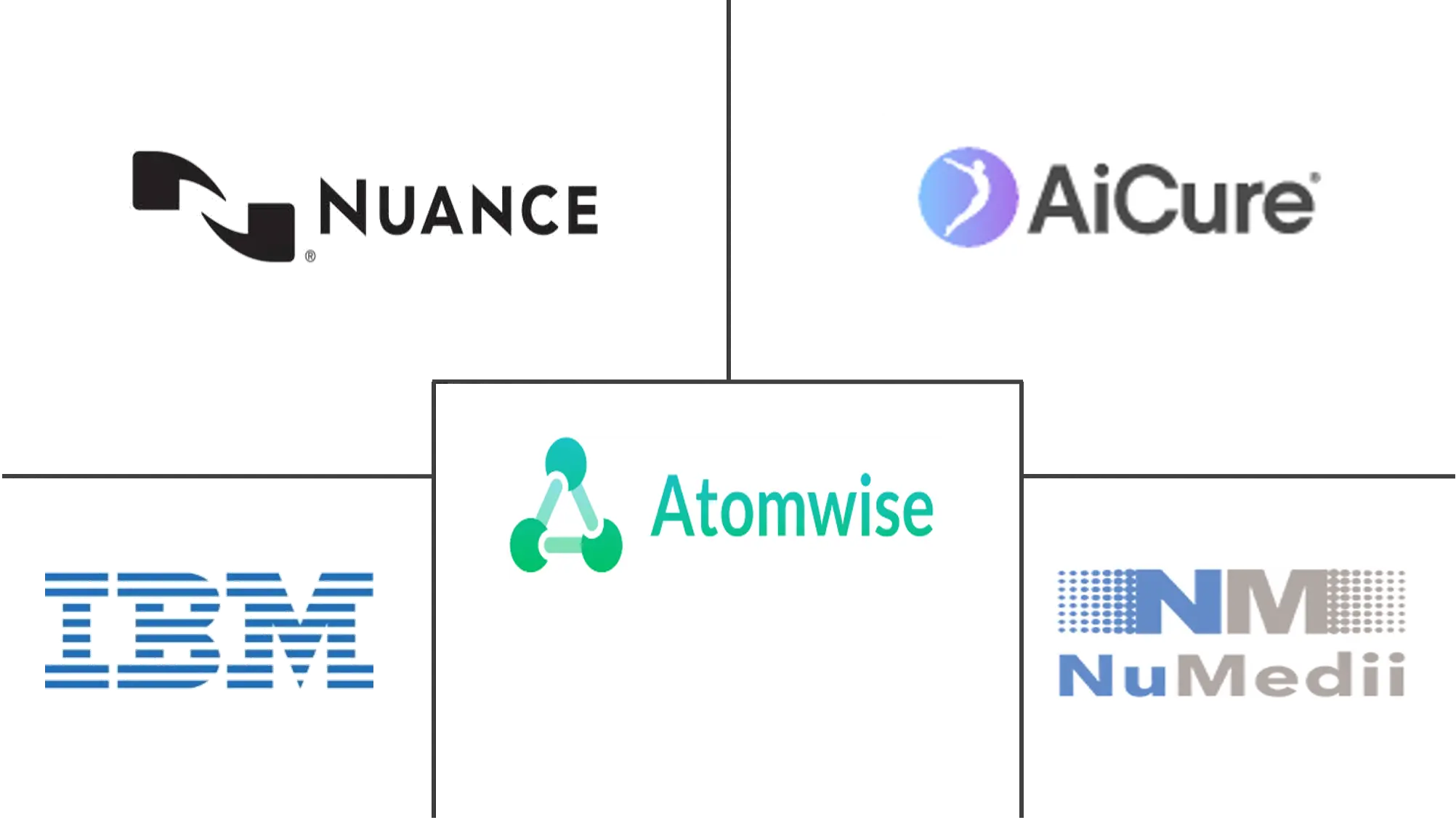AI In Life Sciences Market Size and Share
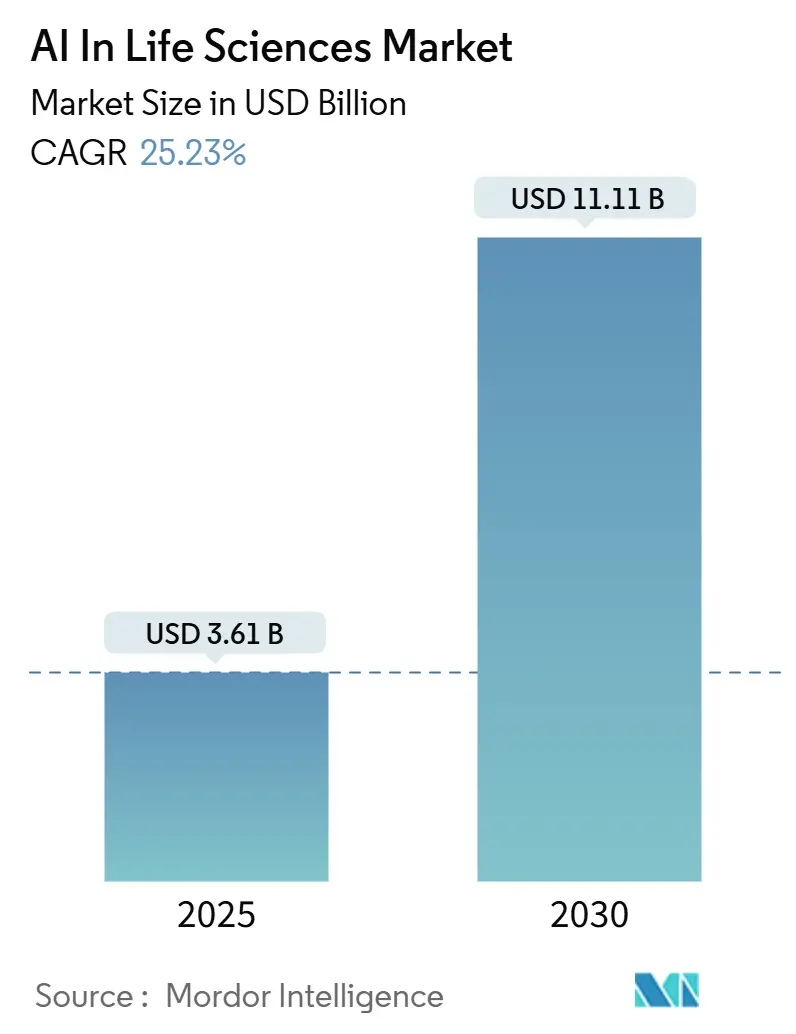
AI In Life Sciences Market Analysis by Mordor Intelligence
The AI in life sciences market is valued at USD 3.61 billion in 2025 and is forecast to expand to USD 11.11 billion by 2030, registering a 25.23% CAGR. Adoption is accelerating because regulators now regard AI-derived biomarkers as legitimate evidence, and because federated data networks are making once-siloed clinical datasets available for model training. A 70% drop in compute cost per molecule achieved through hyperscaler–pharma alliances is widening access to large-scale simulation, while venture capital inflows into generative protein-design platforms have tripled since 2024. At the same time, only 6% of biopharma data meet FAIR standards, highlighting a parallel opportunity for data-quality solutions. Regionally, North America maintains scale advantages in talent and infrastructure, but Asian government programs are translating into the fastest growth outlook.
Key Report Takeaways
- By offering, software led with 55% of the AI in life sciences market share in 2024, while services are projected to record a 23% CAGR through 2030.
- By deployment model, cloud platforms accounted for 51% of the 2024 revenue base; on-premise solutions are paced for a 17% CAGR over 2025-2030.
- By analytics type, predictive systems held 2024 leadership, yet generative models are set for the sharpest upswing at 27% CAGR to 2030.
- By application, drug discovery captured 26% revenue share in 2024, whereas clinical-trials optimisation is rising at a 21% CAGR during the forecast window.
- By end user, pharmaceutical and biotechnology firms controlled 46% of 2024 demand; CROs represent the fastest expansion path at 18% CAGR to 2030.
- By geography, North America commanded 49% revenue share in 2024; Asia is poised for the highest regional CAGR of 22% through 2030.
Global AI In Life Sciences Market Trends and Insights
Drivers Impact Analysis
| Driver | ( ~ ) % Impact on CAGR Forecast | Geographic Relevance | Impact Timeline |
|---|---|---|---|
| FDA RTOR-enabled AI biomarker approvals | 5.20% | North America; spill-over to Europe | Medium term (2-4 years) |
| EU Health Data Space federated model training | 4.80% | Europe; global multinationals | Long term (≥ 4 years) |
| China Bio-AI pilot programs | 3.70% | Asia, chiefly China | Medium term (2-4 years) |
| Hyperscaler partnerships cutting compute cost | 4.10% | Global; focus in NA and EU | Short term (≤ 2 years) |
| VC surge in generative-protein design | 3.30% | NA and EU; emerging Asia | Medium term (2-4 years) |
| Decentralised-trial mandates | 2.90% | Global early adopters | Medium term (2-4 years) |
| Source: Mordor Intelligence | |||
FDA RTOR-Enabled AI Biomarker Approvals
The US FDA’s Real-Time Oncology Review has shortened review cycles for AI-enabled biomarkers by up to 40%, allowing oncology programmes to reach market far sooner than under legacy pathways. Successful precedent in oncology broadened to neuro-degenerative and rare-disease indications in 2024, signalling regulator confidence in AI-generated endpoints. Each new approval creates knock-on value because the validated biomarker can be reused across separate pipelines, accelerating overall portfolio productivity. With the FDA establishing the global benchmark, other agencies are already evaluating similar expedited tracks, effectively globalising the opportunity.[1]Center for Drug Evaluation and Research, US Food and Drug Administration, “Real-Time Oncology Review Pilot Program,” fda.gov.
EU Health Data Space Unlocking Federated AI Model Training
Effective January 2025, the European Health Data Space (EHDS) is giving life-sciences developers API-based access to harmonised clinical, genomic and imaging datasets across 27 member states. Crucially, federated-learning rules permit model training without physical data transfer, preserving privacy but eliminating a historic barrier of fragmentation. Forecasts point to EUR 11 billion in ten-year efficiency savings via reduced duplication and faster evidence generation. Early adopters are re-architecting pipelines so that algorithms can learn on-site and update centrally—an approach that turns Europe’s stringent privacy stance into a competitive differentiator for compliant vendors.[2]European Commission, “European Health Data Space Factsheet,” ec.europa.eu
China’s 17th Five-Year Bio-AI Plan Fueling above 200 Pilot Programs
China’s latest national plan earmarks AI-biotech convergence as a strategic pillar. More than 200 pilots span genomics, digital pathology and automated chemistry, underpinned by grants and preferential procurement. Provincial competition for funding is producing dense regional clusters that combine local manufacturing with academic research, reducing reliance on imported software stacks. The policy blueprint targets an incremental USD 25 billion uplift to the domestic health-tech economy and positions Chinese suppliers to export turnkey AI solutions once regulatory equivalence with global norms is demonstrated.[3]State Council Information Office of the People’s Republic of China, “14th and 15th Five-Year Plans for Bio-Economy,” gov.cn
Hyperscaler Partnerships Cutting Compute Cost per Molecule by 70%
Joint engineering initiatives between hyperscalers and drug developers are optimising hardware configurations for molecular simulations, slashing per-molecule compute expense by roughly 70% since 2024. A prime example is NVIDIA’s collaboration with Recursion Pharmaceuticals, pairing customised GPU clusters with graph-based drug-discovery algorithms. Cost efficiency means that libraries of billions of synthetically accessible compounds can be screened in days rather than months, improving hit-rate probabilities and shrinking early-stage timelines. Companies securing preferred access to such infrastructure are winning disproportionate deal flow, as smaller peers struggle with inflated spot prices for scarce GPUs.[4]NVIDIA Corporation, “Recursion and NVIDIA Expand Compute Collaboration,” nvidia.com
Restraints Impact Analysis
| Restraint | ( ~ ) % Impact on CAGR Forecast | Geographic Relevance | Impact Timeline |
|---|---|---|---|
| EU AI Act extending CE-mark timelines | −3.1% | Europe; companies marketing to EU | Medium term (2-4 years) |
| Low FAIR-compliant data in biopharma | −2.8% | Global, especially mature markets | Short term (≤ 2 years) |
| GPU shortage raising inference cost | −2.4% | Global; acute in NA and EU | Short term (≤ 2 years) |
| IP ambiguity on AI-generated molecules | −1.9% | Asia (Japan and South Korea) | Medium term (2-4 years) |
| Source: Mordor Intelligence | |||
EU AI Act Delaying CE-Mark Timelines for Clinical AI Systems
Classifying most clinical algorithms as “high-risk,” the EU AI Act, in force since August 2024, layers additional conformity-assessment audits onto the CE-mark process. Smaller innovators, often venture-backed, are hardest hit because they lack in-house regulatory teams, leading to launch delays estimated at 6–12 months for imaging and decision-support tools. Although large manufacturers can absorb the cost, the bottleneck is temporarily reducing the funnel of European AI devices, which in turn slows downstream data generation needed for algorithm refinement.
Only 6% of Biopharma Data Are FAIR-Compliant
Industry surveys indicate that just 6% of current R&D data satisfy FAIR principles, limiting machine-learning models’ ability to generalise across cohorts. Poor metadata, siloed storage and inconsistent ontologies inflate the data-wrangling phase that precedes model training. Organisations that invested early in knowledge graphs and data-governance offices show materially higher model accuracy, underlining the economic case for quality improvements. Vendors offering automated curation pipelines and ontology alignment stand to benefit as pharma budgets re-balance toward foundational data assets.
Segment Analysis
By Offering: Software Dominates, Services Accelerate
The software component generated 55% of the 2024 revenue base, establishing code libraries and algorithm suites as the primary value driver within the AI in life sciences market. Leading platforms analyse omics data, suggest candidate molecules and predict trial enrolment feasibility, embedding directly into pharmaceutical pipelines. Vendors increasingly differentiate through explainability modules that document model lineage for auditors. Services, though representing a smaller slice, are expanding at a 23% CAGR across 2025-2030 as clients seek integration specialists who can align AI outputs with regulated workflows. Managed-service contracts that bundle software licences with validation protocols and post-market performance monitoring are gaining traction because they transfer compliance overhead from sponsors to vendors.
Hardware, while modest in revenue share, is strategically important. Specialised accelerator boards designed for stochastic differential-equation solvers and high-throughput docking address current GPU supply constraints. Enterprises are adopting mixed infrastructure strategies—on-premise clusters for sensitive data and burst-to-cloud capacity for large screening jobs—to hedge against supply volatility and enforce data-residency rules. The AI in life sciences market size attached to hardware segments is forecast to grow at a mid-teens rate as new semiconductor entrants release domain-specific architectures.
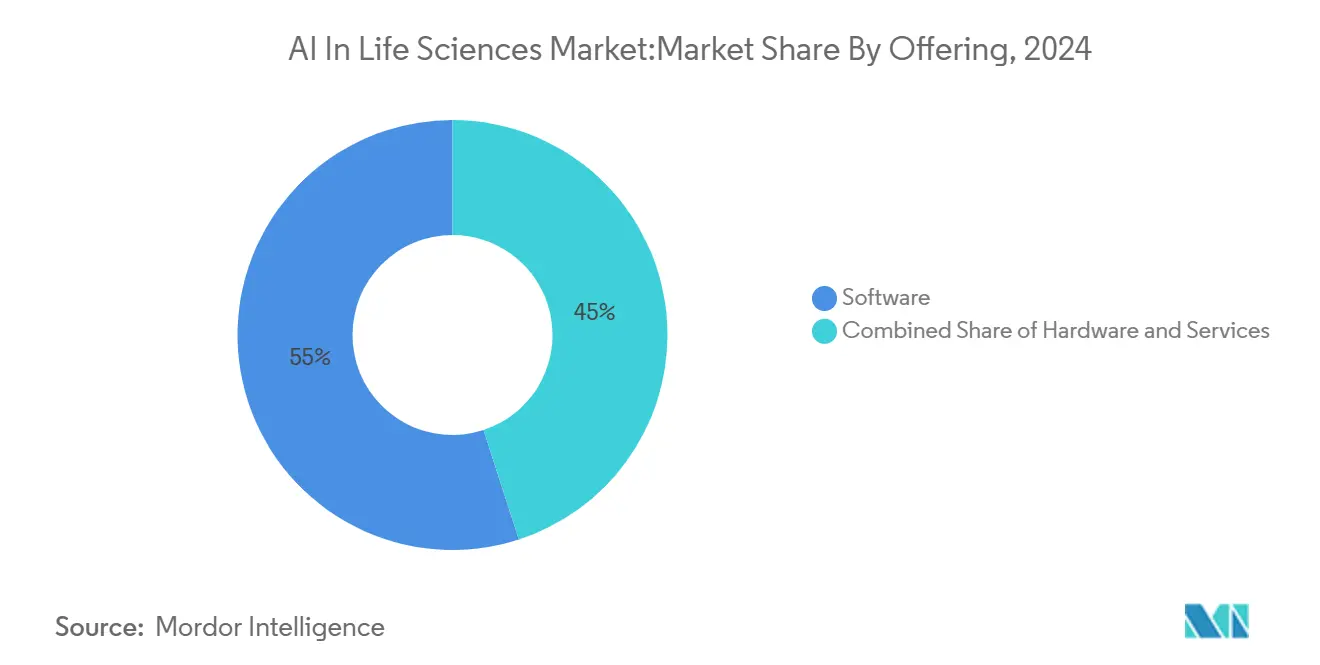
Note: Segment shares of all individual segments available upon report purchase
By Deployment Model: Cloud Platforms Enabling Collaboration
Cloud deployments captured 51% of spending in 2024, reflecting the sector’s recognition that elastic computing and distributed collaboration outweigh initial security concerns. Hyperscalers now offer health-data-compliant environments with pre-configured audit logs, reducing validation cycles for 21 CFR Part 11 and GDPR. Multi-tenant sandboxing allows academic consortia and biotechs to share de-identified cohorts, accelerating external innovation. Hybrid architectures, however, are becoming the default. Organisations retain ultra-sensitive genomic archives on-premise but run federated analytic workloads in the cloud, improving utilisation rates without sacrificing sovereignty. On-premise solutions, boosted by sovereign-cloud regulations and latency-critical use cases, are projected to deliver a 17% CAGR through the period.
Persistent data silos remain a barrier: 81% of surveyed firms cite difficulty reconciling EHR, imaging and omics data within a single environment. Consequently, platform vendors are packaging built-in extract-transform-load utilities and ontology mappers. This dynamic supports service-led revenue streams that complement subscription fees from software licences, anchoring long-run renewal rates within the AI in life sciences market.
By Analytics Type: Generative AI Reshaping Discovery
Predictive analytics retained top-line leadership in 2024, underpinned by statistical and machine-learning models that forecast toxicity, patient response and trial enrolment dynamics. Such capabilities are credited with raising Phase II success odds by up to 15 percentage points. Descriptive and prescriptive layers continue to aid data visualisation and operational decisions, particularly within manufacturing quality-control loops. The generative segment, however, is scaling fastest, with some vendors logging 27% CAGR to 2030. Deep diffusion models and transformer architectures can propose viable small-molecule libraries guided by multi-objective fitness functions. When linked to automated synthesis robots, discovery cycles compress from quarters to weeks, shifting the bottleneck from idea generation to biological validation. The AI in life sciences market size flowing through generative use cases is projected to account for a rising share of overall software spending.
By Application: Clinical-Trials Optimisation Gaining Momentum
Drug discovery applications accounted for 26% of the 2024 revenue pool, driven by AI-enabled target identification across multi-omics datasets. Integration of graph-neural networks with cheminformatic rules has broadened exploration of “undruggable” targets. The AI in life sciences market share for clinical-trials optimisation is poised to climb as the segment grows at a 21% CAGR during 2025-2030. Algorithms that mine real-world data to refine inclusion criteria are cutting screen-fail rates, while remote-monitoring wearables feed continuous biomarkers that improve safety signal detection. Pharmaceutical sponsors report potential 70% cost savings when adaptive trial designs further reduce protocol amendments. Imaging-based diagnostics, bioprocess optimisation and personalised-medicine decision support remain sizeable niches, each benefiting as foundational models become increasingly multimodal.
By End User: Pharma Leads, CROs Accelerate
Pharmaceutical and biotechnology enterprises represented 46% of spending in 2024 as they embedded AI into R&D, regulatory, manufacturing and commercial operations. Dual strategies are common: internal centres of excellence for proprietary datasets combined with external licensing for frontier algorithms. CROs form the fastest-expanding customer group at an 18% CAGR through 2030 because sponsors outsource analytics-heavy tasks to partners already holding multi-sponsor data troves. The AI in life sciences market size tied to CRO contracts is projected to grow as regulatory bodies encourage data standardisation that multiplies cross-study insights. Medical-device manufacturers, academic institutes and payers constitute the balance of demand, collectively driving ecosystem interoperability.
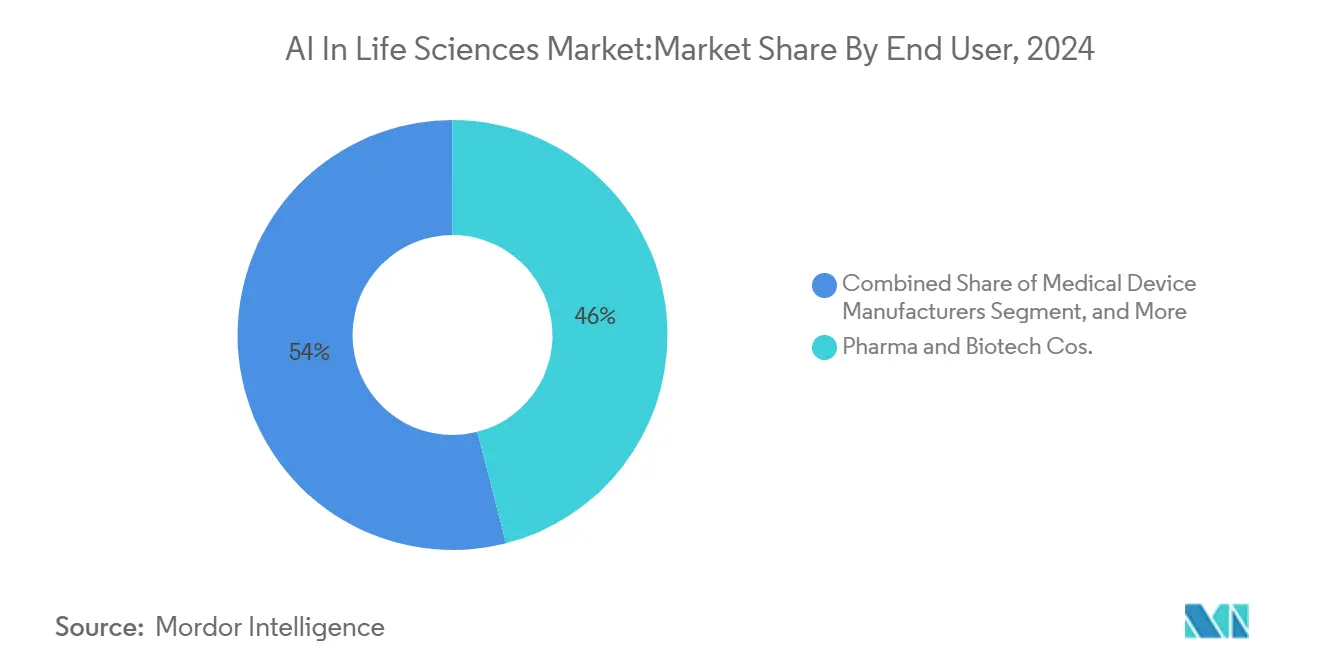
By Technology: Foundation Models Transforming Capabilities
Machine-learning frameworks—gradient-boosting, random forests and classical deep nets—provide the baseline tooling for pattern recognition in structured datasets. NLP now digests clinical narratives, adverse-event reports and regulatory guidance at scale. Computer vision supports high-content screening and histopathology, adding spatial context to molecular predictions. Deep-learning advances have catalysed foundation models that are pre-trained on hundreds of millions of protein sequences or molecular graphs, delivering zero-shot capabilities for new targets. Transfer learning permits rapid fine-tuning, slashing data requirements for niche diseases. Generative architectures constitute the most rapid-growth technology subset: diffusion and variational-autoencoder pipelines that integrate chemical rules and synthesizability constraints can now output bench-ready compounds in silico. Combined with active-learning loops, each experimental assay returns information that the model feeds back into itself, reinforcing a virtuous discovery cycle.
Geography Analysis
North America commanded 49% of 2024 global revenue, anchored by a deep venture capital base, favourable reimbursement codes for digital diagnostics and early regulator engagement. The AI in life sciences market size in the US alone is boosted by the FDA’s RTOR programme, which validates AI-enabled biomarkers that become reusable across multiple development programmes. Multistate health-information exchanges enable richer training sets, although interstate privacy rules still complicate data portability. Cloud-service adoption outpaces other regions because HIPAA-aligned blueprints shorten compliance audits, letting mid-tier biotechs leverage hyperscale compute without building in-house clusters.
Europe remains the second-largest region, poised to accelerate once the EHDS federated networks scale. Industry consortia linking academic medical centres with pharmaceutical sponsors are piloting privacy-preserving cross-border training, likely to increase the AI in life sciences market share captured by European vendors as they leverage home-market regulatory familiarity. Counterbalancing this momentum, the AI Act’s high-risk classification introduces extra documentation layers that can elongate product cycles. Companies are responding by integrating regulatory checkpoints into agile sprints, a practice that, while lengthening early iterations, reduces late-stage remediation costs.
Asia shows the highest growth trajectory at a 22% CAGR between 2025-2030. China exploits coordinated industrial policy to fund AI-enabled drug-discovery megaprojects; provincial biotech parks provide tax holidays and access to national-level supercomputing. Japan and South Korea specialise in robotics and automation, yet lingering IP ambiguity for AI-generated molecules creates a licensing risk premium. India’s contract-research ecosystem leverages large English-language medical records, positioning the country as an outsourcing hub for algorithm training and validation. Divergent national rules dictate a country-by-country go-to-market, but the aggregate opportunity is compelling, with localised cloud regions and sovereign-AI initiatives unlocking new datasets previously inaccessible to global players.
South America and the Middle East and Africa are smaller today but constitute important frontier segments. Brazil’s national genomics programmes and Saudi Arabia’s genome project are generating population-specific datasets that draw AI developers seeking diversity in training inputs. Governments are allocating innovation grants to attract multinational partnerships, a trend that could raise the regions’ combined market share over the next decade as infrastructure and skills mature.
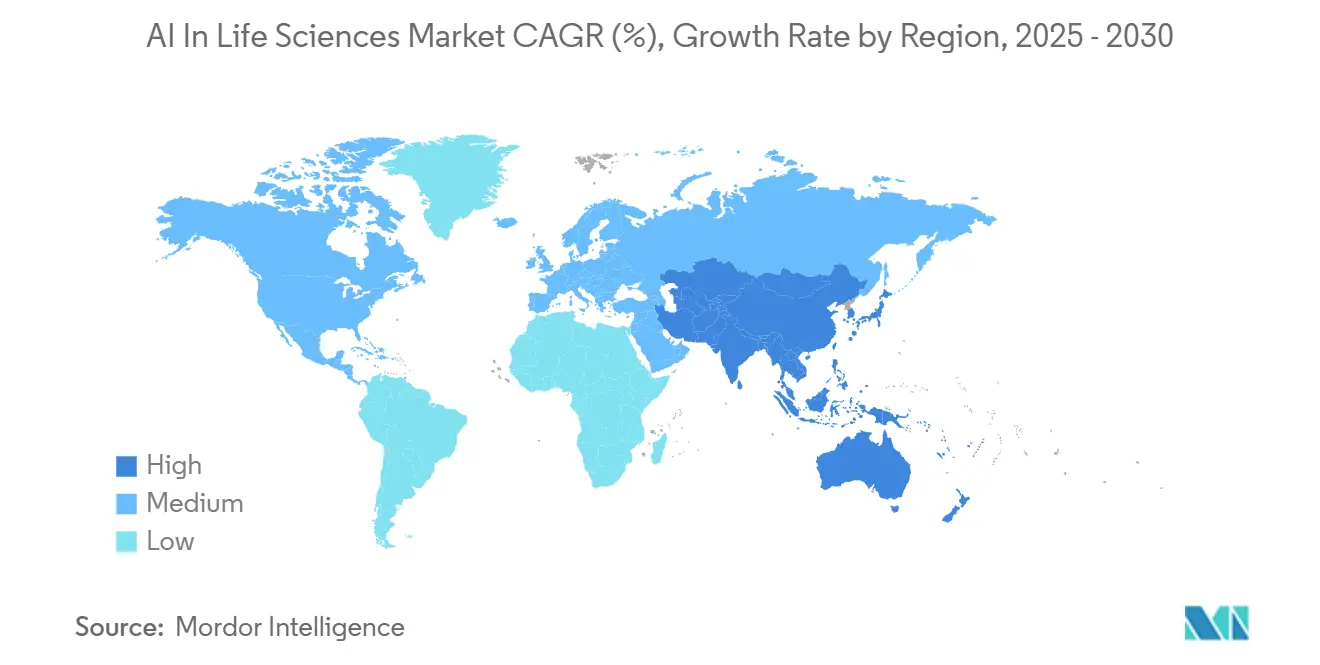
Competitive Landscape
The market is moderately consolidated. IBM, IQVIA and Oracle deliver full-stack platforms that integrate data harmonisation, model training, validation and post-market surveillance. Rather than pursuing all innovations internally, they form joint ventures and acquire niche providers, creating network effects through bundled offerings. The top five firms collectively control about 45% of global revenue, leaving scope for specialised challengers.
Focus differentiation is the hallmark of rising contenders. Atomwise and Insilico Medicine deploy closed-loop systems coupling generative chemistry with automated wet-lab verification, compressing early-stage timelines from years to months. Owkin pioneers federated learning, allowing hospital data to remain on-premise while model parameters travel—a critical requirement under Europe’s GDPR and similar regimes. Hyperscaler cloud credits, equity stakes, and co-marketing agreements are now central to market positioning because they offer startups subsidised compute that can be converted into rapid proof-of-concept results.
Strategic alliances also dominate go-to-market. Pharmaceutical sponsors sign multi-target, multi-year deals that combine upfront cash with stage-gated milestones, aligning incentives across discovery and development. Recent mega-deals confirm that AI partners supplying validated leads can capture economics comparable with traditional biotech licensing agreements. Competitive intensity is therefore shifting from purely algorithmic performance to encompassing proprietary training datasets, compute access and regulatory fluency.
AI In Life Sciences Industry Leaders
-
IBM Corporation
-
NuMedii Inc.
-
Atomwise Inc
-
AiCure LLC
-
Nuance Communications Inc.
- *Disclaimer: Major Players sorted in no particular order
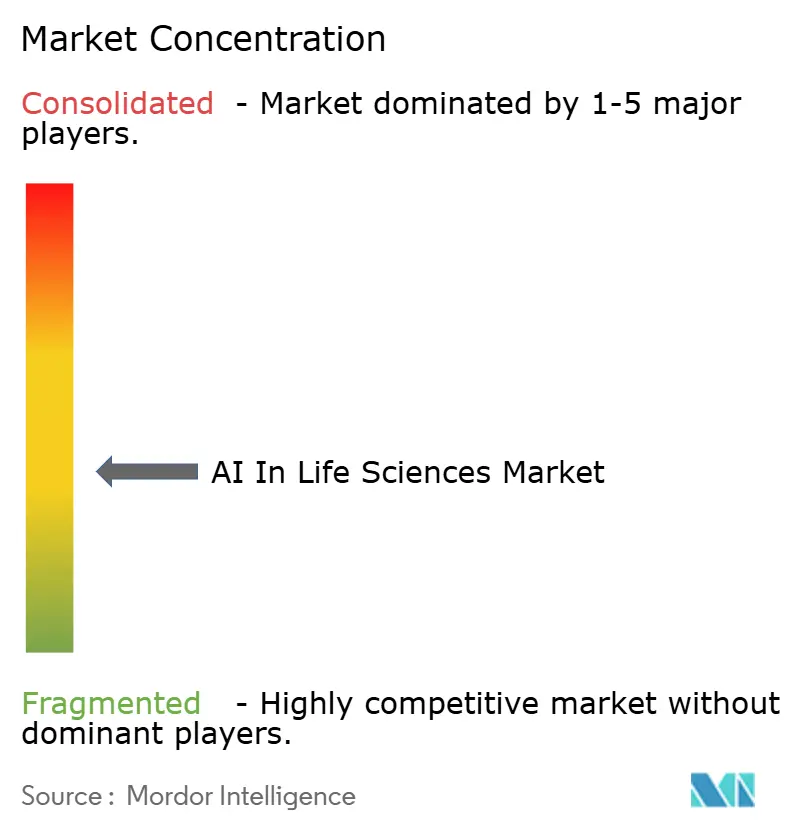
Recent Industry Developments
- May 2025: Incyte and Genesis Therapeutics entered a USD 30 million upfront collaboration (USD 295 million per target in milestones) to deploy the GEMS platform for small-molecule discovery.
- April 2025: AstraZeneca and Daiichi Sankyo secured FDA Priority Review for Enhertu, the first tumour-agnostic HER2 therapy guided by AI-identified biomarkers.
- March 2025: Insilico Medicine released PandaOmics Box enabling on-premise AI target discovery for data-sensitive pharma clients.
- February 2025: Eli Lilly partnered with OpenAI to accelerate antimicrobial discovery using large language models.
Global AI In Life Sciences Market Report Scope
Artificial intelligence (AI) in the life sciences industry is used for various applications, such as drug discovery, biotechnology, medical diagnosis, clinical trials, precision and personalized medicine, and patient monitoring. The study also categorizes the impact of these applications across various regions. AI is a highly data-driven technology. In the life sciences sector, it is commonly employed to make meaningful relations from loosely coupled data. With the introduction of the third wave of AI, it is anticipated that advanced AI solutions can learn and evolve as they find novel applications. The study also assesses the impact of COVID-19 on the industry.
The Artificial Intelligence in Life Sciences Market is segmented by Application (Drug Discovery, Medical Diagnosis, Biotechnology, Clinical Trials, Precision, and Personalized Medicine, Patient Monitoring) and Geography (North America, Europe, Asia Pacific, Latin America, and Middle East and Africa).
The market sizes and forecasts are provided in terms of value (USD million) for all the above segments.
| Software |
| Services |
| Hardware |
| Cloud / On-Demand |
| On-Premise |
| Descriptive |
| Predictive |
| Prescriptive |
| Generative AI |
| Drug Discovery |
| Medical Diagnosis and Imaging |
| Clinical Trials Optimisation |
| Biotechnology and Bioprocessing |
| Precision and Personalised Medicine |
| Patient Monitoring and Real-World Evidence |
| Pharmaceutical and Biotechnology Companies |
| Contract Research Organisations (CROs) |
| Medical Device Manufacturers |
| Academic and Research Institutes |
| Healthcare Providers and Payers |
| Machine Learning |
| Natural Language Processing |
| Computer Vision |
| Deep Learning and Neural Networks |
| Generative AI Models |
| North America | United States |
| Canada | |
| Europe | Germany |
| United Kingdom | |
| France | |
| Nordics | |
| Rest of Europe | |
| Asia Pacific | China |
| Japan | |
| India | |
| South Korea | |
| Rest of Asia Pacific | |
| South America | Brazil |
| Rest of South America | |
| Middle East and Africa | Saudi Arabia |
| United Arab Emirates | |
| South Africa | |
| Rest of Middle East and Africa |
| By Offering | Software | |
| Services | ||
| Hardware | ||
| By Deployment Model | Cloud / On-Demand | |
| On-Premise | ||
| By Analytics Type | Descriptive | |
| Predictive | ||
| Prescriptive | ||
| Generative AI | ||
| By Application | Drug Discovery | |
| Medical Diagnosis and Imaging | ||
| Clinical Trials Optimisation | ||
| Biotechnology and Bioprocessing | ||
| Precision and Personalised Medicine | ||
| Patient Monitoring and Real-World Evidence | ||
| By End User | Pharmaceutical and Biotechnology Companies | |
| Contract Research Organisations (CROs) | ||
| Medical Device Manufacturers | ||
| Academic and Research Institutes | ||
| Healthcare Providers and Payers | ||
| By Technology | Machine Learning | |
| Natural Language Processing | ||
| Computer Vision | ||
| Deep Learning and Neural Networks | ||
| Generative AI Models | ||
| By Geography | North America | United States |
| Canada | ||
| Europe | Germany | |
| United Kingdom | ||
| France | ||
| Nordics | ||
| Rest of Europe | ||
| Asia Pacific | China | |
| Japan | ||
| India | ||
| South Korea | ||
| Rest of Asia Pacific | ||
| South America | Brazil | |
| Rest of South America | ||
| Middle East and Africa | Saudi Arabia | |
| United Arab Emirates | ||
| South Africa | ||
| Rest of Middle East and Africa | ||
Key Questions Answered in the Report
What is the current value of the AI in life sciences market?
The market is worth USD 3.61 billion in 2025 and is projected to expand to USD 11.11 billion by 2030 at a 25.23% CAGR.
Which region generates the highest revenue today?
North America leads with 49% share owing to strong venture funding, regulatory incentives such as FDA RTOR and mature cloud infrastructure.
What is driving the rapid uptake of AI in clinical trials?
Algorithms that refine inclusion criteria, enable remote monitoring and predict enrolment feasibility are pushing the clinical-trials optimisation segment to a 21% CAGR through 2030.
How will the EU Health Data Space influence AI adoption?
The EHDS enables federated learning across 27 member states, reducing data silos while maintaining privacy and is expected to add EUR 11 billion in efficiency gains over ten years.
Why are compute partnerships with hyperscalers important?
Collaborations with providers like NVIDIA have cut compute cost per molecule by roughly 70%, allowing drug hunters to screen far larger virtual libraries within practical budgets.
What challenges could slow market growth?
Key headwinds include extended CE-mark timelines under the EU AI Act, limited FAIR-compliant datasets and ongoing shortages of high-end GPUs that inflate inference costs.
Page last updated on:
